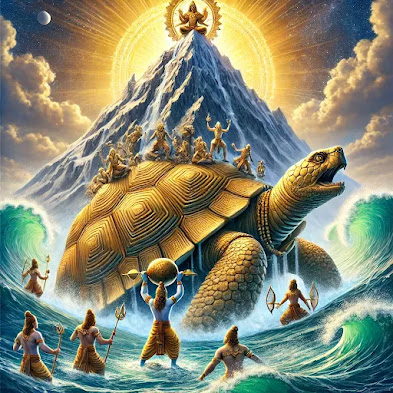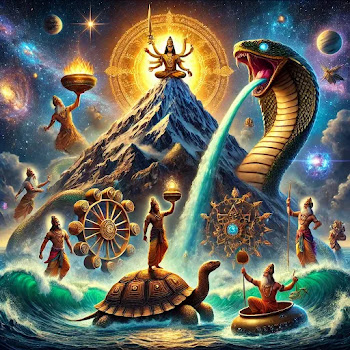Why Shiva Became Neelkanth – The Story of Churning the Ocean (Samudra Manthan)
Why Shiva Became Neelkanth – The Story of Churning the Ocean (Samudra Manthan)
Introduction
The story of Samudra Manthan (Churning of the Ocean) is one of the most important and symbolic episodes in Hindu mythology. It explains the origin of Amrita (the nectar of immortality) and how Lord Shiva came to be known as Neelkanth (the Blue-Throated One). The story reflects the eternal struggle between good and evil, the quest for immortality, and the balance of cosmic forces.
The main sources of this story are found in the:
- Bhagavata Purana (Book 8, Chapter 7)
- Vishnu Purana (Book 1, Chapter 9)
- Matsya Purana (Chapter 250)
- Mahabharata (Adi Parva)
The Vedas, especially the Rigveda and Yajurveda, also make indirect references to the churning of the ocean and the emergence of Amrita. Let us explore the story in detail as narrated in these ancient texts.
1. The Background
Curse of Sage Durvasa
The story begins when Sage Durvasa, known for his quick temper, received a garland from a celestial nymph. He presented it to Lord Indra, the king of the gods. Indra, however, placed the garland on his elephant Airavata, who trampled it underfoot.
Durvasa, insulted by this act of disrespect, cursed Indra and the other Devas:
"You have shown disrespect to the divine gift. May you lose all your strength and splendor!"
(Vishnu Purana, Book 1, Chapter 9)
As a result of this curse, the Devas became weak and vulnerable. The Asuras (demons), led by Bali, seized this opportunity and waged war against the Devas. The weakened Devas were overpowered and lost control over the heavens and the three worlds.
2. Seeking Help from Lord Vishnu
The Devas, unable to reclaim their strength, approached Lord Vishnu for help. Lord Vishnu advised them that the only way to regain their lost strength and power was to obtain Amrita (the nectar of immortality) from the depths of the Kshirasagara (Ocean of Milk).
Vishnu said:
"The nectar of immortality lies hidden within the ocean. It must be churned out using Mount Mandara as the churning rod and Vasuki, the serpent king, as the rope."
(Bhagavata Purana, 8.6.22)
However, the churning of the ocean would require enormous strength. Vishnu proposed that the Devas should seek the cooperation of the Asuras, promising that he would ensure that the nectar was ultimately given only to the Devas.
3. Preparing for the Churning
Mount Mandara and Vasuki
The Devas and Asuras agreed to work together. They uprooted Mount Mandara to serve as the churning rod. However, when they tried to place it in the ocean, the mountain began to sink due to its immense weight.
To prevent this, Lord Vishnu took the form of Kurma (a giant tortoise) and supported the mountain on his back.
"I shall bear the weight of Mount Mandara as Kurma to sustain the churning of the ocean."
(Vishnu Purana, 1.9.31)
Vasuki, the serpent king, was chosen as the churning rope. The Asuras insisted on holding the head of the snake, while the Devas took hold of the tail.
4. The Churning of the Ocean
The Devas and Asuras began to churn the ocean with great effort. Initially, nothing emerged except heat and turbulence. But soon, divine treasures and beings began to surface:
Divine Treasures that Emerged:
- Kamadhenu – The celestial cow that provides milk and all needs.
- Uchhaishravas – The seven-headed white horse taken by Indra.
- Airavata – The white elephant taken by Indra.
- Kaustubha – A radiant jewel worn by Lord Vishnu.
- Parijata – A divine tree with fragrant flowers.
- Apsaras – Celestial maidens.
- Chandra – The moon, which adorned Shiva’s head.
- Goddess Lakshmi – The goddess of wealth and fortune, who chose Vishnu as her consort.
- Dhanvantari – The divine physician who appeared holding the pot of Amrita.
5. Emergence of Halahala (The Deadly Poison)
As the churning continued, a dark, deadly poison called Halahala emerged from the depths of the ocean. Its fumes were so toxic that it began to burn the three worlds — the heavens, the earth, and the underworld.
The Devas and Asuras, terrified, rushed to Lord Shiva for help. They begged him to save the universe from destruction.
Shiva, moved by compassion, said:
"I shall consume the poison to protect creation."
(Bhagavata Purana, 8.7.35)
6. Shiva Consumes the Poison
Lord Shiva took the Halahala poison into his palm and drank it. The poison was so potent that it turned his throat blue. To prevent the poison from spreading through his body, Goddess Parvati pressed his throat, allowing the poison to remain there without harming him.
From that day, Shiva came to be known as Neelkanth (the Blue-Throated One).
"By holding the poison in his throat, Shiva displayed his supreme act of selflessness and sacrifice."
(Matsya Purana, Chapter 250)
7. Distribution of Amrita
After Shiva contained the poison, the churning resumed. Finally, Dhanvantari appeared holding the pot of Amrita.
The Asuras seized the pot and refused to share it with the Devas. At this moment, Lord Vishnu assumed the form of Mohini, a celestial enchantress. Mohini's beauty mesmerized the Asuras, and they willingly handed over the pot.
Mohini then distributed the nectar among the Devas. One Asura, Rahu, disguised himself as a Deva and drank the nectar. However, before the nectar could pass his throat, Vishnu severed his head with his discus. Rahu’s head and body became Rahu and Ketu, the shadow planets.
The Devas regained their strength and overpowered the Asuras, reclaiming their position as protectors of the universe.
8. Symbolism and Meaning
The story of the churning of the ocean holds deep symbolic meaning:
1. Churning of the Ocean
Represents the inner struggle of life and the effort needed to extract spiritual wisdom and truth.
2. Mount Mandara
Represents stability and the axis of spiritual balance.
3. Vasuki
Symbolizes the vital force or Kundalini energy required for transformation.
4. Halahala Poison
Represents the challenges and negativity encountered during spiritual growth.
5. Amrita
Represents enlightenment and the ultimate reward of spiritual discipline.
9. Historical References and Temples
- Ellora Caves – Sculptures depicting the Samudra Manthan are found at the Ellora Caves (6th–8th century CE).
- Angkor Wat – A bas-relief depicting the churning of the ocean is found in the Angkor Wat temple complex in Cambodia (12th century CE).
- Mount Kailash – Shiva’s eternal abode, where he is worshipped as Neelkanth.
The story of Neelkanth teaches the importance of selflessness, balance, and the ultimate victory of good over evil. Shiva’s act of drinking the poison reflects the supreme sacrifice and his role as the protector of the universe.
The churning of the ocean is not just a myth — it symbolizes the eternal struggle for wisdom, balance, and spiritual awakening.
The universe is whispering its secrets—are you ready to listen?
Dare to know more? Enter the realm of cosmic truth.
At the end of this journey, you will never see reality the same way again. Are you ready to break the illusion? Deep dive into www.rudradoota.com
%20from%20Hindu%20mythology.%20Show%20Mount%20Mandara%20being%20used%20as%20a%20churning%20rod,%20supported%20.webp)



.%20Show%20the%20Devas%20and%20Asuras%20pulling%20the%20serpent%20Vasuki%20on%20either%20side%20of%20Mount%20Man.webp)




.%20Show%20ancient%20rock-cut%20sculptures%20of%20gods%20a.webp)
.%20The%20scene%20feature.webp)




0 Comments:
Post a Comment
Subscribe to Post Comments [Atom]
<< Home